I usually find myself overwhelmed by large capital cities around the world. While a country’s major city is usually the jumping off point for many travelers, I find myself much more drawn to foggy mountain towns or sleepy beachside villages than bustling cities. However, Georgia’s capital city of Tbilisi changed my mind completely.
The winding, colorful streets of the city drew me in, and before I knew it I’d walked 15 kilometers on foot with my camera in hand. The city has a way of constantly surprising you — be it a pop-up flea market on the street corner, a hidden back alley covered in murals, or a mom-and-pop cafe selling fresh kachapuri. I actually came back to Tbilisi during my trip to Georgia to continue exploring as I loved it so much.
Tbilisi is not a city trying to put on an act for tourists or only cater to those with money to spend. Rather, Tbilisi is distinctly transparent in revealing the stories of those who call it home — murals line the city walls, booksellers set up shop along bustling streets, posters plaster buildings giving a look into current political thought. Tbilisi has a complicated past, but it does not shy away from sharing the many stories that have contributed to its history, tied together with a distinct sense of Georgian pride.
This site uses affiliate links to share products that I use and love! If you click on one of the links I may receive a small commission at no additional cost to you. This helps keep my site up and running — thank you!
Guided Tours of Tbilisi
Don’t want to explore Tbilisi on your own? Check out some of these guided tours of the city
🚶♀️ Food and Drink Walk of Tbilisi – Discover the flavors of Tbilisi on this unique walking tour!
🍷 Private Tour with Wine Tasting – Discover Tbilisi with a local guide and sample Georgian wine
🏢 Tbilisi Brutalist Architecture Tour – Learn about Tbilisi’s Soviet Architecture on this walking tour
🍽️ Tbilisi Food Tour – Learn to make Georgian food with a local family in Tbilisi

A Brief History of Tbilisi
Located on the crossroads of Europe and Asia, Georgia’s capital of Tbilisi has long been a point of contention for numerous foreign powers. In its centuries-long existence the city has rarely known independence, the years of foreign rule reflected throughout the streets.
Tbilisi was established in the 5th century by King Vakhtang I of Iberia. The location was chosen because of the area’s sulphuric hot springs, reflected in the name T’bilisi, quite literally meaning “warm place.” The Tbilisi sulphur baths are still a popular spot for locals and visitors alike.
While the original capital of Georgia was placed at Mtskheta, King Vakhtang’s successor King Dachi moved the capital to Tbilisi because of its favorable trade location. While Tbilisi’s location was its strength it was also its downfall, and the strategically placed city soon fell to the Persian empire in the 6th century.
Thus followed centuries of foreign control by numerous powers — since it’s establishment, Tbilisi has been under the control of the Byzantines, the Arabs, the Seljuk Turks, the Mongols, the Iranians, and the Russians. Until recently, Tbilisi had only known one period of independence from the 12th-13th centuries, an era known as the Georgian Golden Age or Georgian Renaissance. This period was characterized by booming cultural growth, solidifying Tbilisi’s reputation as a cultural and literary center of the ancient world.

In 1921, Georgia became a member of the Soviet Union, remaining so until the fall of the union in 1991. The streets of Tbilisi reflect this history, with Stalinist architecture nestled among the intricate Georgian balconies and winding pathways of the old city.
The period following Soviet control, known as the “dark 90s,” was characterized by significant instability as Georgia struggled to reestablish itself in a post-Soviet world. However, with the introduction of large scale projects, such as a city-wide streetcar system and large central station, Tbilisi began to recover, once again establishing its reputation as a cultural hub. Artists and activists took to the streets, reclaiming the city and defining what it is today — a uniquely eclectic, vibrant hub of the Caucasus.
These days, Tbilisi does not shy away from sharing the many stories of its past. The architecture of the city reveals the many nations who have claimed it as their own, but the colorful street art depicts a uniquely Georgian identity. It is a city of stories past, present, and future, full of hidden gems and undiscovered treasures.
From the underground vintage scene to the bustling markets, the techno clubs to the stately museums, Tbilisi offers a little bit of something for everyone, continuing to establish its identity throughout the world.
23 Things to do in Tbilisi
Tbilisi has a way of making every place feel undiscovered and off-the-beaten-path. It is a city still gaining a reputation as a travel destination and the result is a feeling of discovery at almost every stop.
Tbilisi is a popular starting point for most travelers in Georgia. If your itinerary allows, I encourage you to spend at least 2-3 days in Georgia’s capital city. Here are 22 of the best places to visit in Tbilisi.
Traveling in Georgia? Check out my Georgia Travel Guide to help you plan the perfect trip!
1. Explore the Abandoned Karmir Avetaran Armenian Church
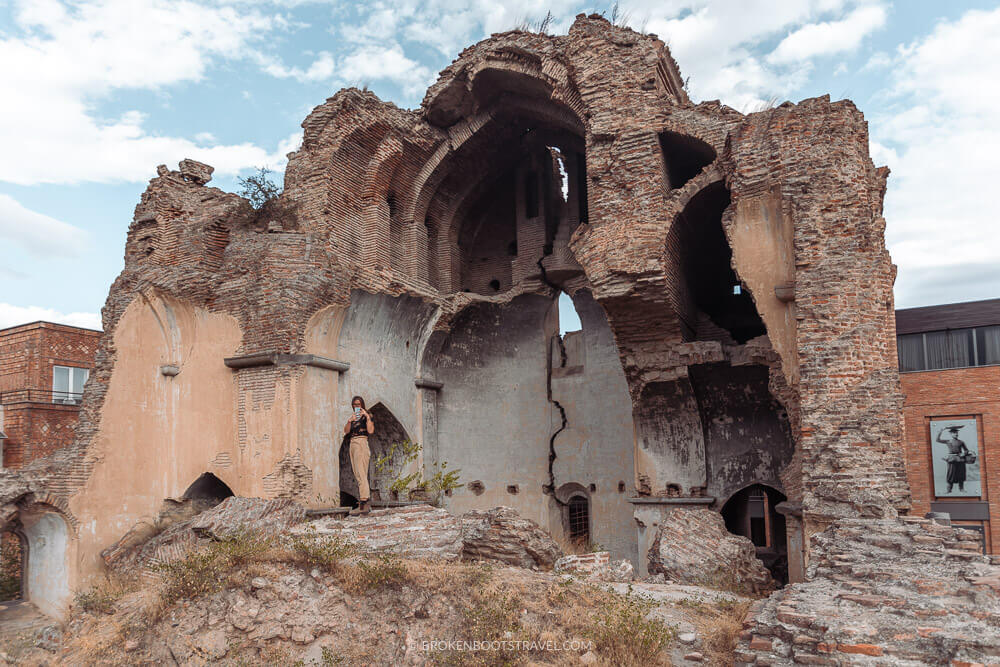
Location: MRR7+FV7, Feristsvaleba St, Tbilisi, Georgia | View in Google Maps
Cost: Free
Y’all know I love abandoned places, so I couldn’t resist visiting the abandoned Karmir Avetaran Armenian Church in the Avlabar district of Old Tbilisi.
Karmir Avetaran was constructed in 1775 but was only in operation as a place of worship until 1937 because of structural damage. However, the building remained in use, first as a bakery, then as a boxing gym, and then finally as studio space. Mystery followed it at every step — the bread refused to rise, the walls made mysterious sounds, and a general air of secrecy accompanied the building. In 1989, the western facade was completely destroyed by an earthquake and the building has remained in ruins ever since.
The building still stands on the banks of the Mtkvari river and is easy to visit from Old Tbilisi. If you do visit, please proceed with caution — the building is old and not structurally sound, so please be careful where you step.
2. Shop for Secondhand Gems at Metro Vintage
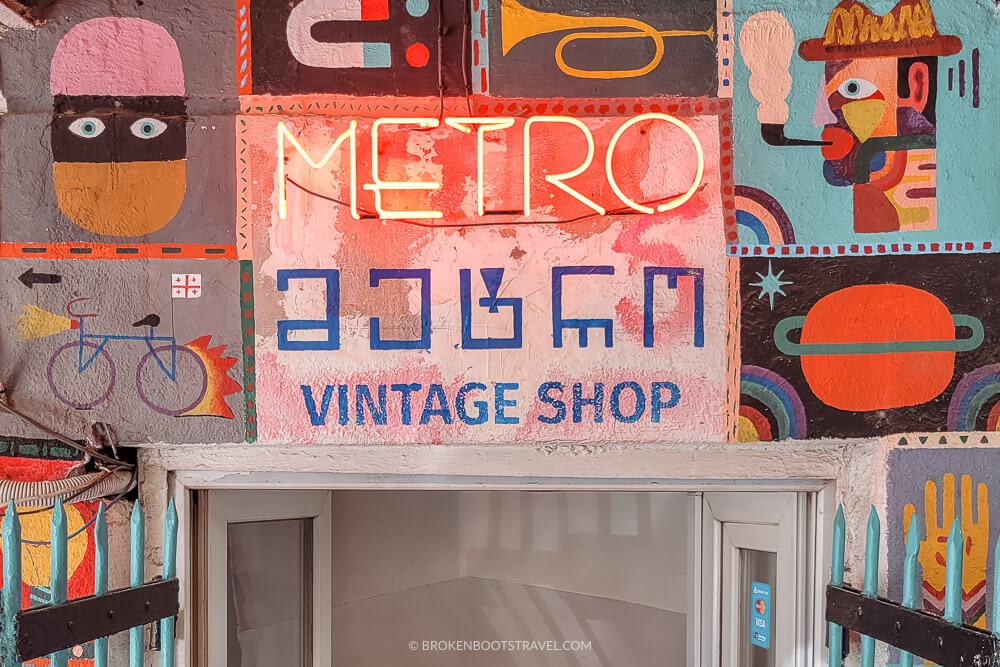
Location: 18 Alexander Griboedov St, Tbilisi, Georgia | View in Google Maps
Cost: Free to visit, pieces priced between 10-60 GEL ($3.50-$20 USD)
The vintage and secondhand scene in Tbilisi is booming, and as an avid thrifter, I had to check it out. My favorite spot I stumbled upon was Metro Vintage. This hole-in-the-wall spot is located under the Ethno Hotel in Tbilisi’s Rustaveli District but packed full of vintage gems for extraordinary prices. I had to resist buying everything on the 10 GEL ($3.50 USD) rack out of consideration for the space in my backpack.
With a rise in popularity for secondhand shopping, vintage and secondhand stores are popping up all around Tbilisi. Check out this guide from Fabrika Hostel for some of the best vintage gems or explore the shops near Tbilisi’s Deserter Bazaar — the original home for secondhand shopping in the city!
Want a local to show you the best thrifting in town? Discover where the locals shop with this guided tour of the best vintage stores in Tbilisi!
3. Get lost underneath the Old City Wall

Location: Start at the Subway at 19 Aleksandr Pushkin St, Tbilisi 0105, Georgia | View on Google Maps
Cost: Free
Upon refurbishing the central Pushkin Street in 2012, remnants of Tbilisi’s Old City Wall were discovered. Constructed in the 12th century, this fortified wall once surrounded the city, warding off invaders and protecting residents from attack. The wall was more or less successful – multiple layers suggest the wall had to be rebuilt on multiple occasions after the city was attacked by invaders.
These days, you can walk along the Old Wall underneath the city. Starting from the Subway Restaurant on Pushkin Street, take the ramp down to explore along the wall. The path will ultimately lead you to the Shota Kavlashvili Sculpture, memorializing one of Tbilisi’s most famous architects.
4. Shop for Roses at the Tbilisi Flower Market
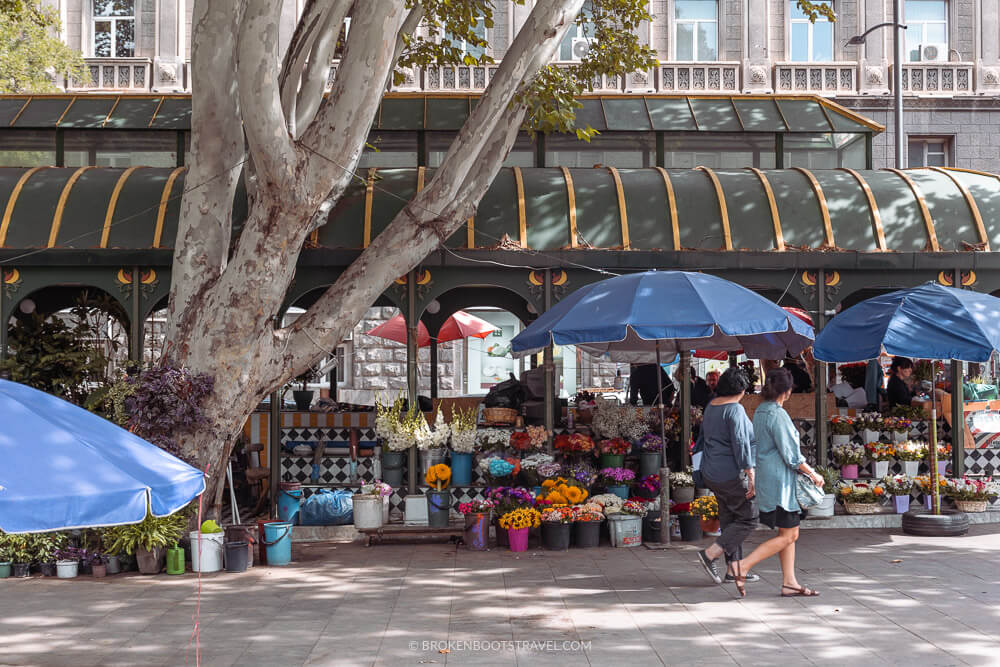
Location: 8 Revaz Tabukashvili St, Tbilisi, Georgia | View on Google Maps
Cost: Free to visit, flower prices ranging
Located in Tbilisi’s notable Orbeliani Square, this famous flower market is one of the best things to see in Tbilisi. The market is bustling at all times of day with vendors arranging everything from freshly-cut roses and bundles of sunflowers.
You can smell the flower market before you even arrive, the sweet scents of daffodils wafting from the arched pavilions through the city. No matter what time of day you visit, you’re certain to see plenty of locals haggling for the best prices.
The flower market is located right next to Gr. Orbeliani Garden, a small park with a beautiful fountain out front. If you’re visiting during the winter season, Orbeliani Square and Gardens are home to one of Tbilisi’s most beautiful outdoor Christmas Markets
5. Explore the Tbilisi Art Scene at the National Gallery


Location: 11 Shota Rustaveli Ave, Tbilisi, Georgia | View on Google Maps
Cost: 10 GEL ($3.50 USD) for students, 25 GEL ($9.00 USD) for adults
I’m a total art freak at heart, so when my new Georgian friend Mariam suggested we visit the Georgian National Gallery jumped at the opportunity, especially since we heard they had Niko Pirosmanashvili’s most notable work, “Fisherman in a Red Shirt,” on display.
The National Gallery is located right off of Rustaveli Avenue and is home to some of Georgia’s most notable works of art. Georgia has a long history of artistic tradition, and Tbilisi is currently booming as a creative hub for art, fashion, and music. The National Gallery is home to a number of Georgian artists old and new and reveals common themes throughout Georgian art across time — pulling from medieval imagery, religious themes, and daily life in the Caucasus.
6. Admire the tiled stairs at the Tbilisi State Academy of the Arts

Location: 22 Alexander Griboedov St, Tbilisi 0108, Georgia | View in Google Maps
Cost: Free
Tbilisi State Academy of the Arts was the first institution for higher arts education in the Caucasus and is located in Tbilisi’s Rustaveli District, a hub for arts and culture. You can actually visit the interior of the academy, but no matter what I recommend taking a walk by the building to view the tiled stairs.
Lined with clay tiles in traditional Georgian painted style, this staircase is also home to a number of murals and graffiti done by art students. The clay tiles themselves were created by two artists at Ceramic Room, a local pottery shop located in the Vera District of Tbilisi.
Clay pottery has a long history in Georgia. Georgian ceramics date back to the Neolithic period, with pottery taking on both a functional and artistic role. To this day, ceramics play an important role in many longstanding Georgian traditions, most notably the creation of large clay qvevris to make Georgian qvevri wine. This art installation pays homage to the many clay traditions of the country.
7. Shop at the Outdoor Artisan Market at the Georgian National Academy of Science
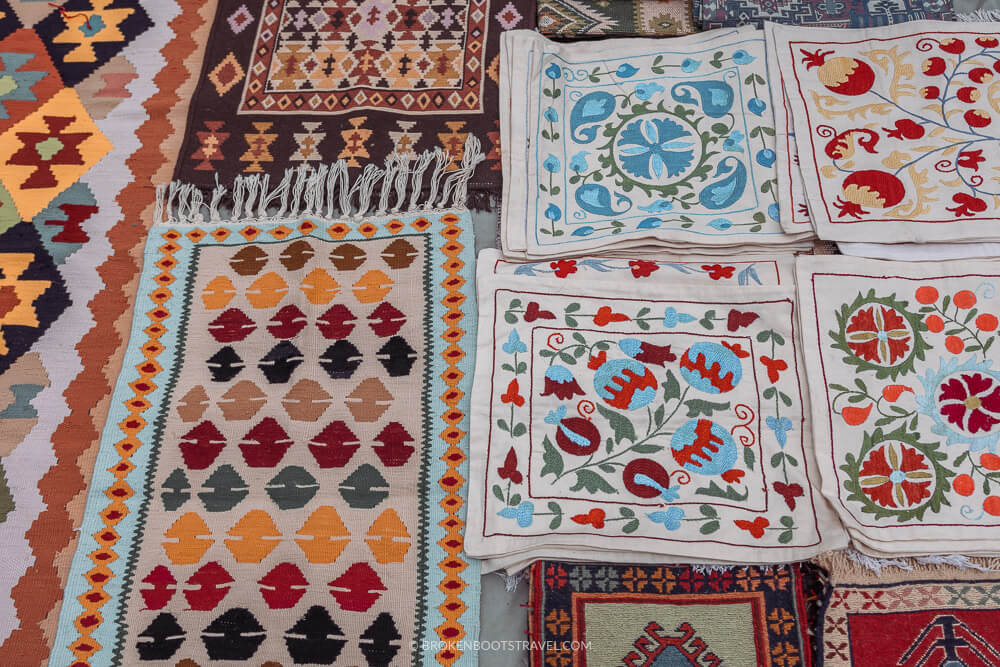
Location: 52 Shota Rustaveli Ave, Tbilisi, Georgia | View on Google Maps
Cost: Free to visit
Located right outside of the Georgian National Academy of Sciences Building on Rustaveli Avenue, local artisans gather every morning to sell a variety of handmade goods in an eclectic outdoor market. You’ll definitely be able to find a variety of kitschy Georgian souvenirs to bring home, but it’s also a great place to shop for handmade art, locally-made jewelry, and Georgian textiles.
Don’t be afraid to haggle for prices with vendors — most of them are willing to give a little on the original price offered. As a haggling rule of thumb, always start with a lower offer than you expect to pay. This gives you and the vendor some wiggle room, and generally results in you paying much less than the original offer!
8. Eat khinkali at Cafe Daphna

Location: Dry Bridge, 29 Atoneli St, Tbilisi, Georgia | View in Google Maps
Cost: 1.2-1.5 GEL per khinkali ($0.43-$0.50 USD)
I practically ate my weight in khinkali during my time in Georgia, but luckily I had a great introduction at Cafe Daphna. This soup dumpling is almost everywhere in Georgia, but this is easily the most delicious khinkali I had in Tbilisi. Not to mention the setting is adorable — the pink walls and arched doorways give the restaurant a Spanish-style feel, and the colorful neon lights surrounding the bar provide a perfect transition from lunch to dinner.
Serving 6 different types of khinkali as well as traditional Georgian cuisines, Cafe Daphna is one of the best places to visit in Tbilisi, perfect stop-in while wandering the Rustaveli district or visiting the nearby Orbeliani Flower Market. I tried one of each type of Khinkali and left only 10 Lari poorer and full for the rest of the day.
9. Splash in the fountains at 9 April Park
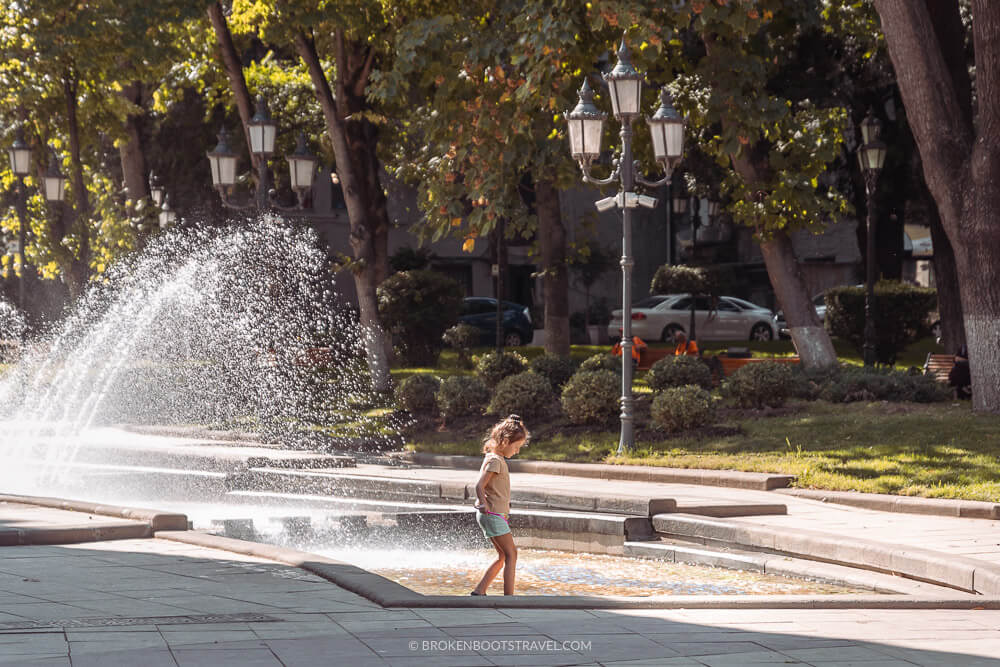
Location: 27 Atoneli St, Tbilisi, Georgia | View on Google Maps
Cost: Free
9 April Park has a tragic and heavy history. The site was home to a mass anti-Soviet demonstration in 1989, which ultimately turned violent resulting in 20 deaths. The demonstration was a turning point for Georgian opposition to Soviet occupation, ultimately leading to their independence in 1991. 9 April Park memorializes this event and those who lost their lives in the fight for independence.
These days, the 9 April Park is a tranquil and peaceful space off the bustling Rustaveli Avenue. Complete with shady pine trees and numerous benches on which to relax, 9 April Park’s real draw on a hot summer afternoon is its tiled creek, perfect for splashing under the Tbilisi sun.
Keep an eye out for the monument to Lado Gudiashvili at the entrance to the park — this prominent Georgian artist made waves throughout the 20th century with his monumentalist work.
10. Sip a glass of saperavi at 8,000 Vintages


Location: 60 Irakli Abashidze Street, Tbilisi 0162, Georgia | View on Google Maps
Cost: Average of 30-60 GEL ($10.00-$20.00) per person for wine and food
With over 500 grapes varieties grown throughout the country, it can be overwhelming to know where to begin with Georgian wine. Luckily, 8,000 Vintages is here to get you started.
True to their name, this wine bar and cafe offers thousands of wines from winemakers across Georgia, inviting people from around the world to come and sample the diversity and uniqueness of the vintage. Their staff is happy to introduce you to the wine varieties in stock and help you select the perfect bottle of wine for your tastes.
There are four locations throughout Tbilisi, but I went to the one in Vera with my Georgian friend who lives nearby. For those staying near the Old Town, the 8,000 Vintages on Revaz Tabukashvili Street would be closest by walking or bus. This is a popular spot, so if you’re visiting the most central location, I recommend calling ahead in advance.
If you visit, you have to try one of their famous boards. We split the Foreign Cheese Board (35 GEL/$12.00 USD) and it changed my life.
11. Eat a Georgian breakfast (or party it up!) at Lolita

Location: 7 Tamar Chovelidze St, Tbilisi, Georgia | View on Google Maps
Cost: 12-40 GEL ($4.00-$15.00 USD) per person
I didn’t see Kikliko on many menus in central Tbilisi, but upon seeing it on the menu at Lolita, and my Georgian friend describing it as “Georgian French Toast,” I was all in.
If you visit Lolita for nothing more than the Kikliko, fried bread served with cured ham, gouda, and decadent sulguni cheese, I don’t blame you. However, this perfect brunch spot takes on another life in the evenings, when the open-air bar starts dishing out specialty cocktails and the best selection of Georgian wine. Tbilisi has been putting in the work to become the “next Berlin,” with the rise of rock and techno clubs around the city, but for those wanting a little nightlife without all the flashing lights, Lolita is a great place to start.
Whether you’re coming for brunch, lunch, or a late night party, try the Latte Macchiato — just trust me.
12. Enjoy cheap and delicious noodles at Fire Wok

Location: 20 Shalva Dadiani St, Tbilisi, Georgia | View on Google Maps
Cost: 10-15 GEL ($3.50-$5.00 USD) per person
I honestly could hardly believe my eyes when I saw the bill for my heaping carton of udon at Fire Wok — for only ten lari, I was stuffed for dinner and still had enough for lunch the next day.
This Tbilisi chain doesn’t skimp on portion sizes or flavor. Choose your base, your sauce, and your add-ins, and watch your meal cooked to order right in front of you in a giant wok. Once it’s finished, the heaping serving is added to a paper carton, the perfect Asian-takeaway for a chilly Tbilisi night.
I love Asian food, so I’m always craving a bowl of noodles wherever I am in the world. Luckily, Fire Wok had made an impact on Tbilisi. I personally visited the Dadiani location in Old Tbilisi, but with 2 additional locations in Vake and Saburtalo, you can get crispy fried rice or chewy glazed udon noodles all over the city.
13. Get lost in Tbilisi’s Old Town
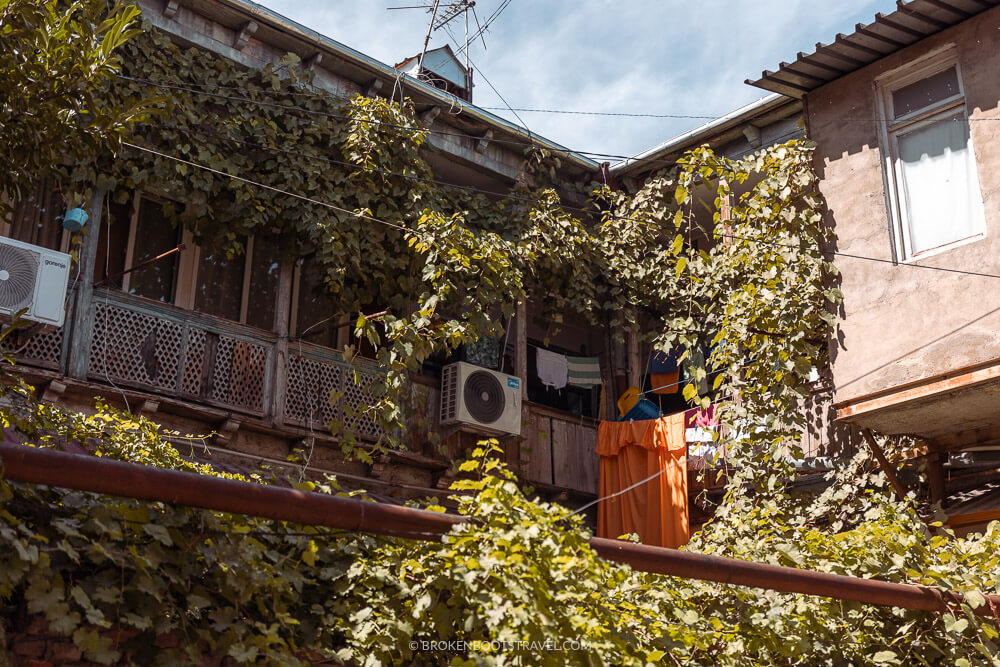
Location: MRV3+FP4, Kote Afkhazi St, Tbilisi, Georgia (central point) | View on Google Maps
Cost: Free
I could have spent my entire time in Tbilisi just exploring the Old Town. Seriously.
With winding stone streets and colorful laundry hanging amongst the grape leaves, I was in a street photographer’s paradise exploring the Old City with my camera in hand. I spent hours wandering the twisting roads between Freedom Square and the Mtkvari River, stopping here and there to photograph the picturesque alleyways and old Georgian balconies hung with grapes. If you too love old buildings and quiet streets, I recommend setting aside a few hours just to wander.
If you really want to see most of the Old Town, I recommend walking from the Old City Wall in the direction of the Tbilisi Cable Car (about 1.5 kilometers). You’ll see plenty of the Old City, as well as pass by the occasional cafe or restaurant if you’re craving a bite to eat.
Don’t want to explore the Old Town on your own? Check out this guided group tour of some of the best spots!
14. Climb to the Narikala Fortress for sunset

Location: MRQ5+4R8, Tbilisi, Georgia | View on Google Maps
Cost: Free
The Narikala Fortress is one of the biggest attractions in Tbilisi for good reason – not only is it the city’s oldest fort, but home to the best sunset views!
You can hike to the Narikala Fortress from Old Town Tbilisi, or take the Tbilisi Cable Car up to the top to avoid the steep climb. Either way, make sure you arrive a little before the sun goes down to enjoy the amazing ruins of the crumbling fortress. Once the sun goes down, I recommend taking the Narikala Tourist Route trail back into Old Town Tbilisi, offering sweeping views of the sparkling skyline at every turn.
Narikala was established upon the foundation of the city and has been an icon of the Tbilisi skyline since the 4th century. The building itself reflects Tbilisi’s many foreign rulers, with the name “Narikala” even said to derive from the ancient Persian word for fortress. The building was damaged by an earthquake in the 1820s and never fully restored, so visitors can walk among the crumbling ruins to learn more about Tbilisi’s history.
15. Sample spices at the Deserter Bazaar

Location: 5 Abastumani St, Tbilisi, Georgia | View on Google Maps
Cost: Free
Tbilisi’s Deserter Bazaar is packed with fresh spices and hanging walls of churchkhela, the stalls bustling with vendors weighing fresh cuts of meat and sulguni cheese. The bazaar is a sensory overload but in the very best way.
Come hungry and ready to haggle — vendors here are ready to share their flavorful products with you and ready to complete for the best prices. The Deserter Bazaar has two sections — the indoor area, home spices of every color and aisles stacked with walnuts, and the outdoor area, where vendors sit in their truck beds alongside heaps of fresh fruit and vegetables. Give yourself time to explore both areas, but practice saying “no, gmadlobt,” for the swarm of excited vendors.
16. Party or picnic in Gudiashvili Square and L’ado
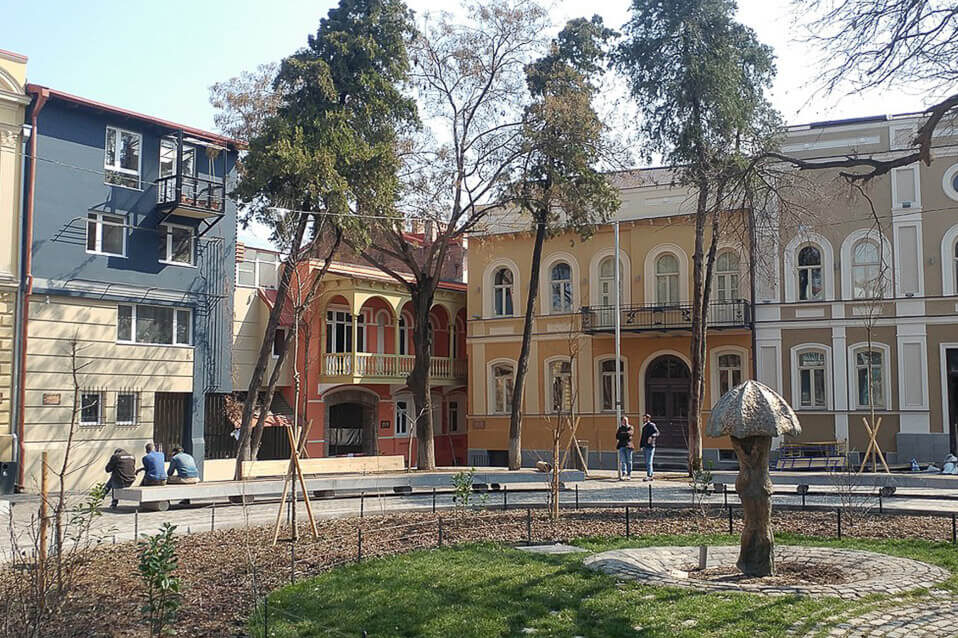
Location: 1 Abo Tbileli St, Tbilisi, Georgia | View on Google Maps
Cost: Free to visit, cocktails from 15 GEL ($5.00)
Whether you’re looking to picnic or party, Tbilisi’s Gudiashvili Square has everything you need. Located right off of Dadiani Street in Old Tbilisi, a street home to many popular restaurants and bars, this square is the perfect space for enjoying your takeout with its wide benches and large wooden tables.
After you’ve enjoyed your meal and admired the Georgian architecture, walk to the adjacent L’ado by Valiko, located right off of Gudiashvili Square. This funky cocktail bar offers a variety of craft cocktails and DJs from around the world, not to mention the vibes are simply ~immaculate.~ The location is pet-friendly as well, so if you’ve ever wanted to go clubbing with your dog, now is your chance.
17. Admire Tbilisi’s Blue House

Location: 54 Shota Rustaveli Ave, Tbilisi, Georgia | Open on Google Maps
Cost: Free
Tbilisi’s Blue House is a cultural landmark hidden behind the bustling Rustaveli Avenue. The house was built in 1898, by architect Cornell Tatishchev as the dream home of Prince Vasil Gabashvili. The house has remained in the family ever since, continuing to house descendants of Gabashvili. One of these descendents includes son-in-law, Nicholas Kipshidze, one of Joseph’s Stalin’s primary doctors during Soviet occupation of Georgia.
In 1990, tragedy struck, as the Blue House was located next door to the site of the Tbilisi cable car crash. The station still remains abandoned next door to the home off of Shota Rustaveli Ave.
There’s a lot more history to the Blue House and I encourage you to check out this article to learn more about the family that calls it home.
To visit the Blue House, simply walk through the outdoor market at the Georgian National Academy of Sciences Building and you’ll see both the abandoned cable car station and the intricate Blue House in juxtaposition.
18. Indulge in a glass of fresh-squeezed pomegranate juice

Location: All along Rustaveli Avenue | View on Google Maps
Cost: 5-20 GEL ($1.75-$7.00 USD) depending on size
The streets of Tbilisi are packed with vendors selling freshly-squeezed juice and you’d be doing yourself a disservice if you didn’t indulge at least once. Most vendors offer orange and pomegranate, though I’ve seen the occasional peach and apple at a stand here and there.
I’d recommend the pomegranate juice — sweet, tangy, and refreshing, straight from the fruit.
Vendors spot many of the major roads, from Rustaveli Avenue to Dadiani Street. If you’re lost, just ask a local for “ts’veni” — most of them probably have their tried and true vendor!
19. Listen to the buskers along Sololaki Street
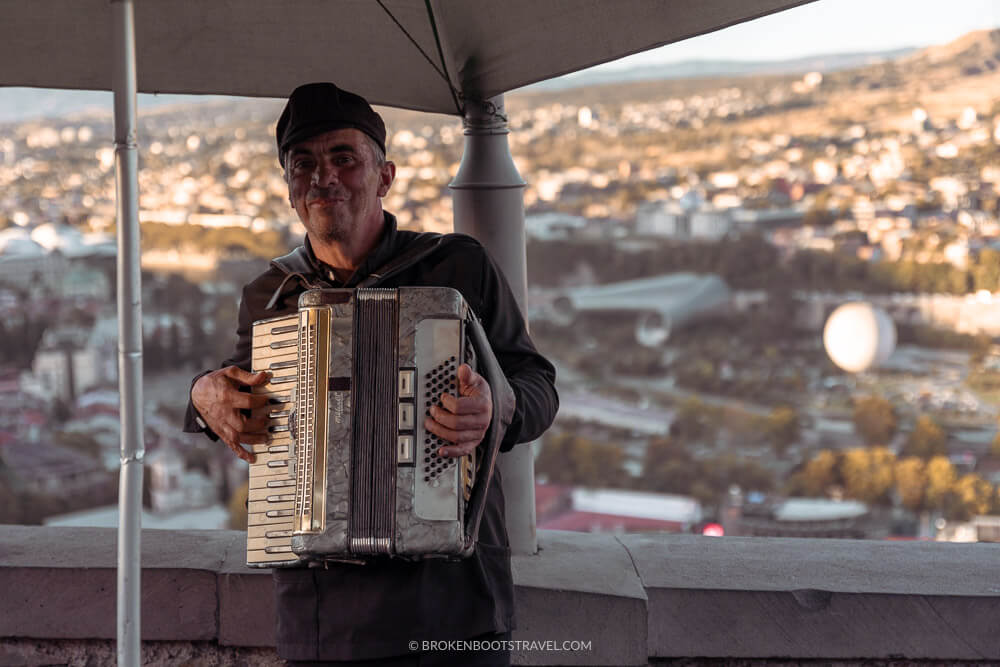
Location: MRQ4+6VM, Narikhala, Tbilisi, Georgia | View on Google Maps
Cost: Free (though feel free to tip a few Lari!)
Spotting the city skyline along the Narikala Tourist Route (Sololaki Street), buskers fill the air with music as the sun sets behind the city. One man plays an accordion, the case beside him slowly filling up with lari. He asks where I’m from, and when I respond he immediately breaks into the US National Anthem, laughing with me the whole time.
Sololaki Street may be one of the most touristed walks in Tbilisi, but it’s still worth a visit. Not only is the street filled with music of all kinds, but it’s arguably one of the best views in all of Tbilisi. Walk along the street as the sun sets over the ridge and enjoy the music welcoming in the night sky.
20. Haggle for antiques at the Dry Bridge Market

Location: PR23+96X, Tbilisi, Georgia | View on Google Maps
Cost: Free to visit
Flea markets are my weakness, but after scoring a working film camera for only 15 GEL ($5.00 USD) at the Dry Bridge Market, I can officially say this is my favorite flea market of all time.
This open-air flea market takes place every day on the “dry bridge” over Dadeena Park. Beginning in the 90s as a way for locals to support their families after the fall of communism, the market has now taken on a life of its own, displaying everything from handmade jewelry to medieval-era swords. The Soviet-era camera collection was unbelievable, and as a total camera geek you know I was loving it.
The market is also home to plenty of Soviet-era memorabilia. Stalin sneaks up on you when you least expect it, and the hammer and sickle are stamped on rusty mint tins and telephones. It is a reminder of Georgia’s past but also signifies a turning point for the country, each vendor telling unique Georgian stories.
21. Say Hello to the Mother of Georgia
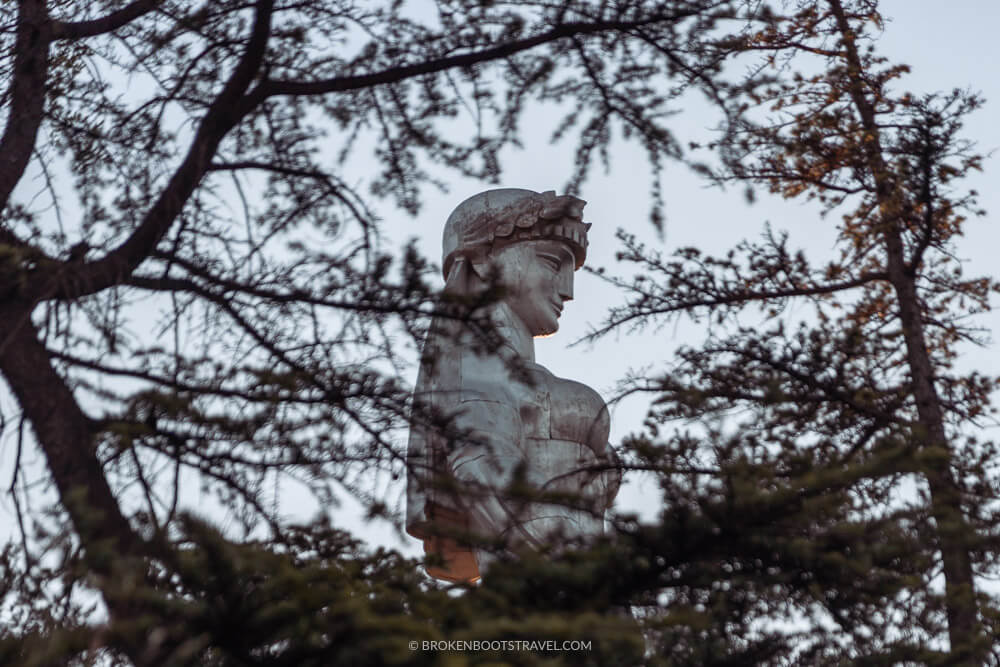
Location: 13 Betkemi Riase, Tbilisi, Georgia | View on Google Maps
Cost: Free
The monumental Mother of Georgia towers over Tbilisi, welcoming friends with a bowl of wine and enemies with a sword. These two features define the Georgian character — mindful of the importance of Georgian hospitality while also recognizing Georgia’s challenging history with foreign invaders. Overlooking the city, she stands as a symbol of peace, justice, and Georgian pride.
Dressed in traditional Georgian clothing, this monument has been a landmark of Tbilisi since 1958 when it was designed by notable Georgian sculptor Elguja Amashukeli. Today, you can easily walk to the sculpture from the Narikala Fortress or National Botanical Gardens. Perhaps the best view of the Mother of Georgia comes from the nearby cable cars — where you can achieve panoramic views of the statue with her beloved Tbilisi in the background.
22. Ride the Tbilisi Cable Car

Location: MRR6+Q7C, Tbilisi, Georgia | View on Google Maps
Cost: 2.50 GEL ($0.90 USD) per passenger one way
Cable cars fill the sky in Tbilisi, and no trip to the capital would be complete without an aerial view of the city from above. Hop on at the cable car station in Rike Park, or ride down from the top of the Narikala Fortress. Either way, you can’t beat the sweeping views of the Mtkvari River and the ancient churches dotting the banks.
If you’re really daring, one of the cable cars has a glass floor, giving you 360 views of the city. When you visit the cable car station, ask the attendant about this car and they should be able to help you locate it. Prepare to wait for a bit — if the car has just left, you’ll have to wait for it to go all the way around again!
23. Visit the Tbilisi Sulphur Baths
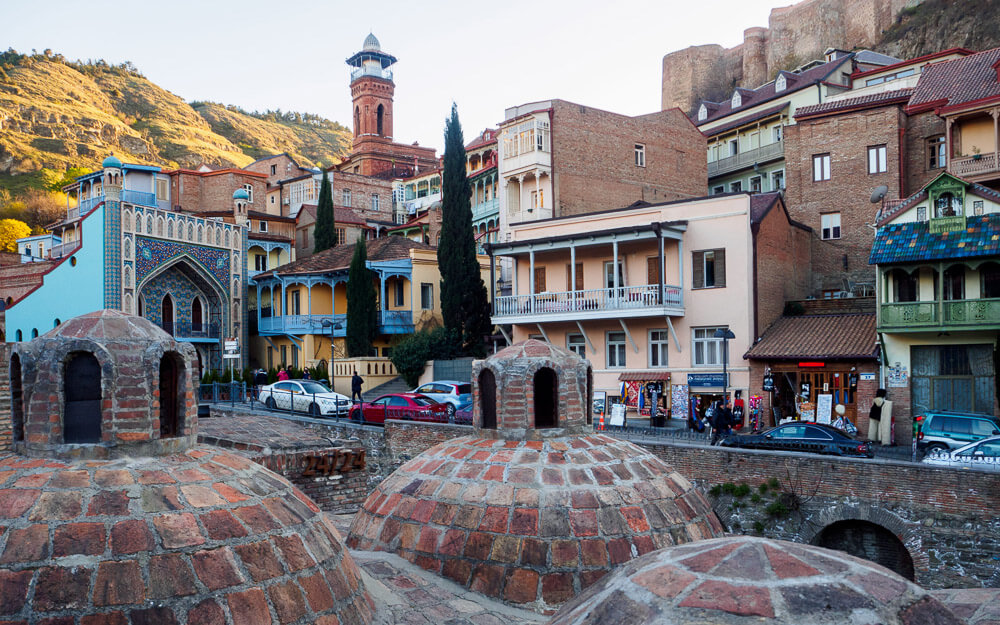
Location: Abanotubani District, Tbilisi, Georgia | View on Google Maps
Cost: 10-500 GEL depending on public/private and amount of luxury
A locally-beloved tradition, visiting a bathhouse is a Tbilisi staple – after all, Tbilisi means “warm place!” The city was built upon natural hot springs and to this day is home to a number of public and private bath houses heated by the natural sulfur springs that run below the city.
Most of Tbilisi’s bath houses are in the Abanotubani district, a neighborhood in Old Tbilisi that resides beside the river. It’s one of Tbilisi’s most iconic neighborhoods, characterized by a number of beehive-shaped buildings. These buildings are the original bath houses, built like domes to allow more ventilation for sulphuric steam!
You can choose between a public bath house (more budget-friendly) or a private bathhouse (more expensive) for a different experience. Private bath houses will often offer spa treatments, but public bath houses are a true local experience. I recommend visiting both if you have the time!
Curious which bath house to visit? Check out this guide to the best bathhouses in Tbilisi.
Where to Stay in Tbilisi

I stayed at Moosica Hostel in the heart of Tbilisi and highly recommend it. The hostel was clean and quiet and located in Tbilisi’s arts district, meaning you could hear opera wafting through the air in the afternoons. While I slept in the mixed dormitory, they also offered private rooms for affordable prices.
Here are a few more recommendations in Tbilisi:
Budget: Fabrika Hostel ($): Hosted in a former Soviet sewing factory, a stay at this funky, eclectic hostel feels like taking a step into Tbilisi’s history. The hostel has both dorm and private rooms available for all kinds of travelers.
Mid-Range: The Terrace Boutique Hotel ($$): Featuring sweeping views of Old Town Tbilisi and a delicious on-site restaurant, this is the perfect option for folks looking for a little more luxury without breaking the budget.
Luxury: Stamba Hotel ($$$): Houses in a former publishing house, this eclectic hotel is the perfect mix of vintage and contemporary. Even better yet, it’s home to Cafe Samba, where guests can try everything from craft cocktails to artisan chocolate.
Find all the best places to stay in Tbilisi on Booking.com and Hostelworld.com
Georgia Quick Links
✈️ Flights – Use Kiwi.com or WayAway to find the cheapest and fastest flights to the Georgia (the country!)
🛏️ Accommodation – Find the best places to stay throughout Georgia on Booking.com
✅ Get Insured – I personally use Safety Wing Nomad Insurance for my travels all around the world! VisitorsCoverage is another great option.
🚗 Rent a Car – Find the best deals for a Georgia road trip on RentalCars.com
🗺️ Find Things to Do – Check out Get Your Guide or Viator for exciting adventures all around Georgia
☎ Buy a Sim – Airalo offers eSIMS for over 200 countries and regions

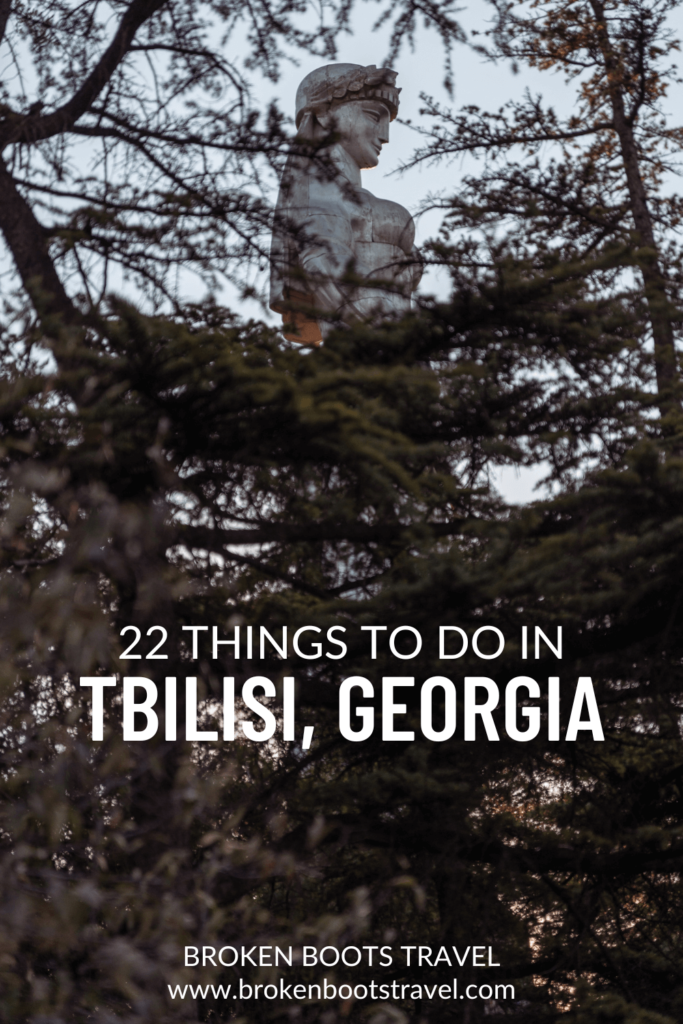


Love stories? Subscribe to my newsletter to get my latest updates delivered straight to your inbox every month. One email a month + no spam? Sign me up!
Virginia Taylor (Ginna) is a travel writer and photographer exploring the world until her boots wear through. She’s currently on a mission to explore all 32 departments of Colombia, though she formerly called the Middle East home. Want to know more? Visit the About Page.

I think I’d love Tbilisi & I can relate completely when you say you prefer smaller towns as I often feel overwhelmed by large cities. But Tbilisi looks completely charming, full of history & culture. I enjoyed reading & thanks so much for the inspiration> I’m saving this for later!
I’m so glad you enjoyed it! I think one of the things that made Tbilisi feel so approachable for me is that it’s so walkable — you can get almost anywhere on foot!
That looks like a very interesting place to visit. The stuffed “French” toast breakfast sandwich reeled me in. That and all of the history. Thanks for including the map – I am geographically challenged when it comes to some of the smaller countries and I could not place it.
Kikliko might be my new favorite breakfast EVER! Thanks for reading! 🙂
I almost moved to Tbilisi a few years ago because of a volunteering program, but life got in the way and I had to cancel my plans. Reading all these unique things to do, see, and visit hits me differently since I can perfectly picture myself trying them all! 🙂
Oh I really hope you get the chance to visit some day! I know how life can be, but I know you’ll love Tbilisi when you make it there! 🙂
Pingback: 25 Photos to Inspire You to Visit Georgia (The Country!)
Pingback: What is Rtveli? Celebrating Georgia's Wine Harvest Festival